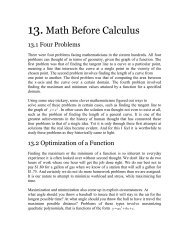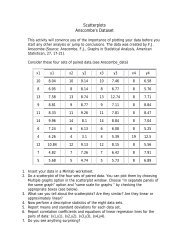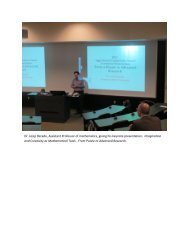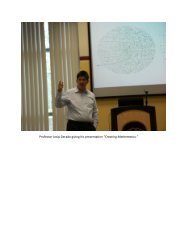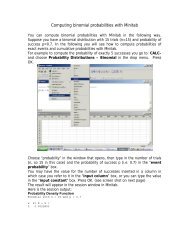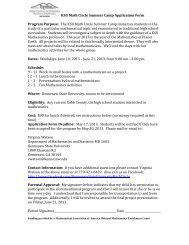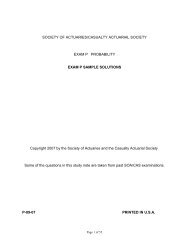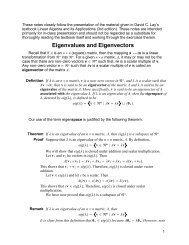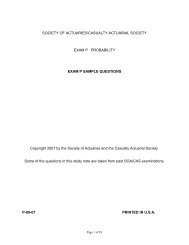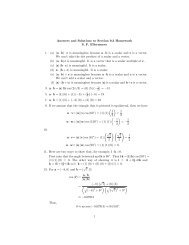P_PracticeExam6_05-1..
P_PracticeExam6_05-1..
P_PracticeExam6_05-1..
You also want an ePaper? Increase the reach of your titles
YUMPU automatically turns print PDFs into web optimized ePapers that Google loves.
PRACTICE EXAMINATION NO. 6<br />
Let<br />
W = 10Y<br />
and<br />
Z = 25X ! 10Y .<br />
This defines a transformation<br />
( W ,Z ) = ! ( X,Y ) = ( 10Y ,25X " 10Y ),<br />
whose inverse is<br />
! "1 W + Z<br />
( W , Z ) =<br />
25 ,W<br />
# &<br />
$<br />
%<br />
10'<br />
( .<br />
You might wonder: how do I know that I am supposed to pick W = 10Y? In fact, you are not<br />
supposed to pick anything. Your objective is to find a second function of X and Y such that you<br />
will be able to find the inverse of the transformation so obtained. There is no unique answer. In<br />
this case, W = Y would do the job, so would W = 25X + 10Y, and so would inifinitely many other<br />
choices. The key insight is that you must be able to quickly find ! "1 and then find the<br />
determinant of its derivative (the Jacobian). Let us find that derivative now (we switch to lower<br />
case variables because this is what we will use in the density calculation):<br />
! "1 ( ) # % $x $x ( % 1 1 (<br />
' $w $z * ' 25 25 *<br />
( w,z ) = ' * = ' * .<br />
' $y $y * ' 1<br />
0 *<br />
&'<br />
$w $z ) * &'<br />
10 ) *<br />
Therefore,<br />
" !x !x %<br />
! ( x, y)<br />
$ !w !z '<br />
= det $ ' = (<br />
! ( w, z)<br />
$ !y !y '<br />
# $ !w !z &'<br />
1<br />
250 .<br />
This gives<br />
( ) = f X,Y x w, z<br />
f W ,Z w,z<br />
( )<br />
( )<br />
" x, y<br />
( ( ), y( w,z ) ) !<br />
" w, z<br />
1 1<br />
= !<br />
400 250 =<br />
1<br />
100000 .<br />
We also have to figure out the ranges for w and z. As w = 10y and 0 < y < 20, we have<br />
0 < w < 200. Also, as 0 < x < 20 and 0 < y < 20, and<br />
z = 25x ! 10y,<br />
we have<br />
!w < z < 500 ! w<br />
as well as<br />
!z < w < 500 ! z.<br />
Graphically,<br />
ASM Study Manual for Course P/1 Actuarial Examination. © Copyright 2004-2007 by Krzysztof Ostaszewski - 265 -



